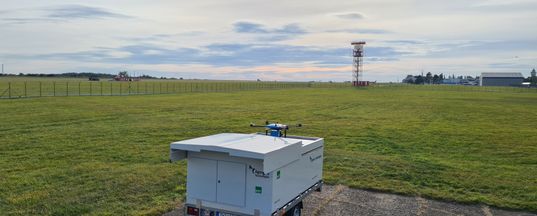Gorgon X8 drone is used for ammunition drop and reconnaissance. Its key features are advanced localization and navigation capabilities supported by antijamming and antispoofing modules combined with a resilient and robust communication system. The system is designed for easy transport and rapid deployment using a foldable frame and antenna mast. Protection of the operator is increased by the decoupling of radios from the ground control station. The drone allows a modular payload combining different ammunition or other cargo types, e.g. supplies, and medical kits.
Gorgon X8
Unmanned System for Ammunition Drop and Reconnaissance

Key features
- Improved resilience against electronic warfare systems
- Rugged design for deployment in harsh conditions
- Autopilot for autonomous missions and complex failsafe mechanisms
- Modular payload mounting and ammunition drop system
- Horizontal ammunition mounting for optimal flight characteristics
- Foldable body for easy transport and fast deployment
- Transportable in a small vehicle
- UAS operator and maintenance training program
Onboard equipment
- Robust localization and navigation system with antijamming and antispoofing capabilities
- EW protected digital communication system for C2 and video
- EO/IR camera with 10x optical zoom for reconnaissance and targeting
- Optional external localization system
- Optional pilot view camera
Ground segment
- Separation of UAS operator from radio signal sources
- Durable GCS design for harsh conditions
- Custom telemetry, map view and video streams from EO/IR cameras
- Fast deployable lightweight antenna mast
- High-gain sector or tracking antennas
Customization
- Highly modular system, various payload options, e.g. LiDARs, multispectral cameras, RF spectrum analyzers
- Possible integration of customer demanded localization, communication, and EO/IR equipment
- Specific customization based on customer’s requirements
| DIMENSIONS | |
| Operational | 100 × 95 × 31 cm |
| Transport | 67 × 62 × 31 cm |
| Diagonal wheelbase | 132 cm |
| WEIGHT | |
| Drone with batteries | 13 kg |
| MTOW | 25 kg |
| Max. payload | 12 kg |
| FLIGHT ENVELOPE | |
| Max. horizontal speed | 15 m/s |
| Ascend | 5 m/s |
| Descend | 3 m/s |
| Service ceiling above sea level | 3.500 m |
| Operational altitude | 300 m |
| Max. wind resistance | 7 m/s |
| FLIGHT TIME | |
| Base load (TOW 13 kg) | 60 min |
| Operational load (TOW 22 kg) | 25 min |
| Tactical radius | 8 km |
| Flight preparation | 10 min |
| BATTERIES | |
| Charge time (0 - 100 %) | 90 min |
| Charge time (20 - 90 %) | 45 min |
| Capacity | 30 Ah |
| TEMPERATURE | |
| Charging / operational | -20°C to 50°C |
| Optimal storage | 20 °C to 30 °C |
| REMOTE CONTROL | |
| Operation time | 3 h |
| Control | touch screen push/toggle buttons joysticks |
Drone Dock
Robotic Drone Docking Station for Automated Perimeter Protection
Drone Dock is an automated solution for perimeter protection using drones. The system is designed to be fully unattended and deployed in remote or hazardous areas. The system‘s key feature is the safe execution of automated flight using the built-in flight control system, which includes collision resolution, geofencing, and system status monitoring. An essential system component is a ground robotic station performing a robotic replacement of the drone’s batteries. The system is designed for two basic modes of operation: 24/7 surveillance or as a first response unit.

Key features
- Fully automated drone operation system
- Surveillance of remote and inaccessible areas
- Near-continuous operation achieved by robotic battery replacement
- Static installation or mobile version for rapid deployment
- System of first intervention within operational distance
- Seamless integration with existing security systems
- Highly secure access and advanced logging
- Backup power supply and protection against all weather influences
UAS platform
- Antijamming and antispoofing GNSS navigation
- Compatibility with various radios (Doodle Labs, Persistent Systems, Silvus Technologies)
- Electro-optical and thermal camera mounted on a stabilized gimbal
- Optional external localization system
- Automated, semi-automated, or remote-control operation modes
- Optional onboard image processing and AI-based autonomy
- Optional add-on sensors or EW equipment
Ground segment
- Self-reliant control of the whole system
- Hangar for off-limit weather conditions, air-conditioning, defrosting
- Radio modem with omnidirectional or tracking antenna
- Optional integration of third-party perimeter protection sensors
- Weather station for the detection of off-limit weather conditions
- ADS-B receiver for the detection of incoming air traffic
- Powerful computing hub for processing data at the deployment site
Customization
- Special equipment for operation in extreme climate conditions
- Independent power supply from a combustion generator
- Global satellite internet connection
- Specific customization based on the customer’s requirements

